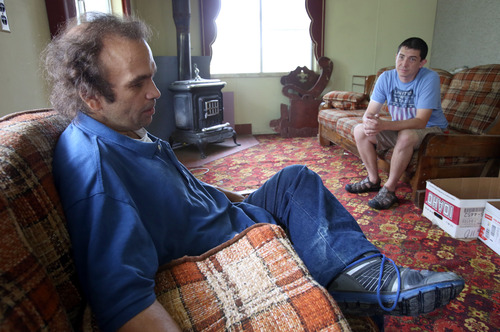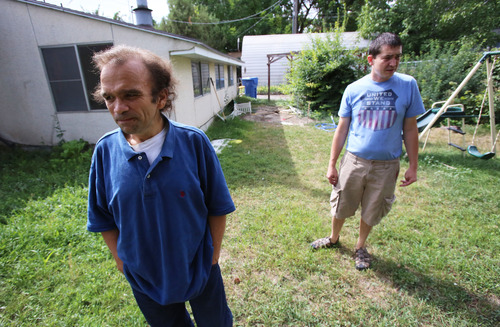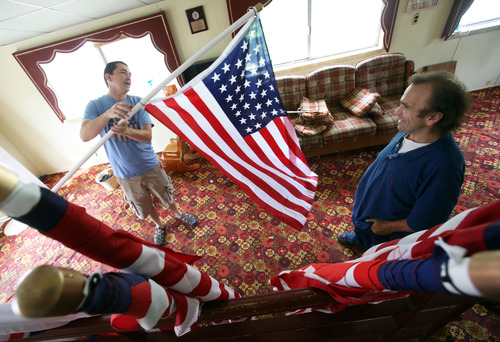This is an archived article that was published on sltrib.com in 2013, and information in the article may be outdated. It is provided only for personal research purposes and may not be reprinted.
After getting laid off in March, DeVaughn Simper — a Taylorsville father of three young children — knew he had little time to waste to find another job and a way to pay the bills.
Simper grew up as a foster child and said he voluntarily exited that system at age 16. Now 32, he has a passion for vexillology (the study of flags) and is working a new job as incident manager for an IT company.
Right after being laid off, Simper sought help from Utah's Department of Workforce Services, began receiving unemployment and food stamps and also decided to sublet the basement of his house as a Section 8 rental.
There are two types of federally subsidized housing: public housing, in which the subsidy is tied to a specific residential project; and Section 8, which provides vouchers that can be used anywhere.
The latter is limited, and individuals can languish on waiting lists for more than five years.
Steven Roe, a struggling Midvale paralegal who had been living in county public housing, finally obtained his Section 8 voucher four months ago and responded to Simper's ad.
"I took a chance," Simper said about Roe, who was down on his luck at the time but trying to get back on his feet. "I looked at his track record. He used to live in the same religious boundary as my brother and sister. I just felt good about it, and I needed someone in there pretty quick."
Roe moved into Simper's basement at the end of April. But to his dismay, the approved Section 8 voucher payments did not start to flow until two months later.
"It really did come down to the wire," Simper said of his own worsening financial situation that caused him to come close to evicting Roe. And Roe said he came close to losing his Section 8 voucher due to the delay, which would have sent him back to the end of the waiting list."We kept getting all kinds of runaround. I'd call the office, and they'd say he hadn't left his other place yet, when clearly he had. It was just a bureaucratic nightmare," Simper said, criticizing what he viewed as a disconnect between public housing and Section 8 staff within the Salt Lake County Housing Authority.
According to Kerry Bate, the agency's executive director, Roe had failed to move all his belongings out of his public housing unit and also to return the keys. For Roe to use his Section 8 voucher, he had to fully conclude his stint in public housing, Bate said.
But Bate agreed that the system is bureaucratic and empathized with their situation: "We don't want landlords and tenants having bad experiences with this program."
In July, Utah low-income advocates bemoaned the shrinking funding of Section 8 vouchers due to federal budget cuts and sequestration, one labeling the decreases as "insidious" and "a tearing away of the very foundation of what was a pretty good social welfare system."
At that time, Andre Bartlome, chief financial officer for the county's Housing Authority, said its staff had shrunk due to budget constraints, and that hundreds of Section 8 vouchers statewide had been lost through attrition.
Last week , the Housing Authority of Salt Lake City (HASLC) said its agency is also in crisis with Section 8 vouchers and hopes to tap federal "shortfall funding" in mid-November to prevent having to yank vouchers and put up to 188 households out on the street.
"We've never had to do that before," said HASLC Executive Director Terry Fever-year. "We'll be $150,000 short in what we've committed to landlords through the end of the year."
Those slots disappear due to the competitive grant process, Feveryear said, where requests for future funding hinge on current numbers of voucher holders.
"We're helping 2,300 right now," down from 2,700 due to budget cuts, Feveryear said, "and we don't have enough funding for that right now either."
The Salt Lake City agency closed its five- to six-year waiting list recently due to lack of funds, Feveryear said.
But there are hopeful signs the economy is rebounding.
Nic Dunn, public information officer for Utah's Department of Workforce Services, said food-stamp caseloads dropped from 113,783 in fiscal year 2012 to 107,391 in 2013. Current caseload in the Family Employment Program is 1,711, down from 2,316 a year ago.
"It's a significant decline, and it looks like we'll keep going in that direction," Dunn said, attributing the drop to more people getting back on the job.
Utah's unemployment rate hovers at 4.6 percent — down from 8.4 percent in December 2009 but still higher than the pre-recession 2.4 percent during the first quarter of 2007, Dunn said.
For Roe, who has survived two bouts of homelessness and hopes to re-establish his paralegal business while living in Simper's basement, the recession still lingers.
"I'd rather be in jail than homeless," Roe said, expressing gratitude for Simper's support. "You get a person who has confidence in you, and that's all you need to make a change."
Twitter: @catmck







